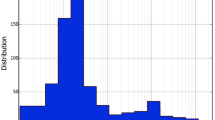Abstract
Possible configurations of the planetary systems of the binary stars α Cen A–BandEZAqr A–C are analyzed. The P-type orbits—circumbinary ones, i.e., the orbits around both stars of the binary, are studied. The choice of these systems is dictated by the fact that α Cen is closest to us in the Galaxy, while EZ Aqr is the closest system whose circumbinary planets, as it turns out, may reside in the “habitability zone.” The analysis has been performed within the framework of the planar restricted three-body problem. The stability diagrams of circumbinary motion have been constructed: on representative sets of initial data (in the pericentric distance–eccentricity plane), we have computed the Lyapunov spectra of planetary motion and identified the domains of regular and chaotic motion through their statistical analysis. Based on present views of the dynamics and architecture of circumbinary planetary systems, we have determined the most probable planetary orbits to be at the centers of the main resonance cells, at the boundary of the dynamical chaos domain around the parent binary star, which allows the semimajor axes of the orbits to be predicted. In the case of EZ Aqr, the orbit of the circumbinary planet is near the habitability zone and, given that the boundary of this zone is uncertain, may belong to it.
Similar content being viewed by others
References
D. Benest, Astron. Astrophys. 206, 143 (1988).
D. Benest, Astron. Astrophys. 223, 361 (1989).
D. Benest and R. Gonczi, Earth, Moon Planets 81, 7 (1998).
D. Benest and R. Gonczi, Earth, Moon Planets 93, 175 (2004).
V. V. Bobylev, Astron. Lett. 36, 816 (2010).
H. F. von Bremen, F. E. Udwadia, and W. Proskurowski, Physica D 101, 1 (1997).
L. Casagrande, C. Flynn, and M. Bessell, Mon. Not. R. Astron. Soc. 389, 585 (2008).
X. Delfosse, T. Forveille, S. Udry, J.-L. Beuzit, M. Mayor, and C. Perrier, Astron. Astrophys. 350, 39 (1999).
L. R. Doyle, J. A. Carter, D. C. Fabrycky, R.W. Slawson, S. B. Howell, J. N. Winn, J. A. Orosz, A. Prša, et al., Science 333, 1602 (2011).
M. Endl, M. Kürster, S. Els, A. P. Hatzes, and W. D. Cochran, Astron. Astrophys. 374, 675 (2001).
M. England, Mon. Not. R. Astron. Soc. 191, 23 (1980).
E. Hairer, S. P. Nørsett, and G. Wanner, Solving Ordinary Differential Equations I. Nonstiff Problems (Springer, Berlin, 1987).
M. J. Holman and P. A. Wiegert, Astron. J. 117, 621 (1999).
Su-Shu Huang, Publ. Astron. Soc. Pacif. 72, 106 (1960).
R. Kopparapu, R. Ramirez, J. F. Kasting, V. Eymet, T. D. Robinson, S. Mahadevan, R. C. Terrien, Sh. Domagal-Goldman, V. Meadows, and R. Deshpande, Astrophys. J. 765, 131 (2013).
V. B. Kostov, P. R. McCullough, T. C. Hinse, Z. I. Tsvetanov, G. Hébrard, R. F. Díaz, M. Deleuil, and J. A. Valenti, Astrophys. J. 770, 52 (2013).
V. B. Kostov, P. R. McCullough, J. A. Carter, M. Deleuil, R. F. Díaz, D. C. Fabrycky, G. Hé brard, T. C. Hinse, et al., Astrophys. J. 784, 14 (2014); Astrophys. J. 787, 93(E) (2014).
V. V. Kouprianov and I. I. Shevchenko, Astron. Astrophys. 410, 749 (2003).
V. V. Kouprianov and I. I. Shevchenko, Icarus 176, 224 (2005).
J. Lissauer, E. Quintana, J. Chambers, M. J. Duncan, and F. C. Adams, Rev.Mex. Astron. Astrophys. 22, 99 (2004).
P. A. Mason, J. I. Zuluaga, P. A. Cuartas-Restrepo, and J. M. Clark, Int. J. Astrobiol. 14, 391 (2015).
A. V. Melnikov and I. I. Shevchenko, Sol. Sys. Res. 32, 480 (1998).
S. Meschiari, Astrophys. J. 752, 71 (2012).
C. D. Murray and S. F. Dermott, Solar System Dynamics (Cambridge Univ. Press, Cambridge, 1999).
S.-J. Paardekooper, Z.M. Leinhardt, P. Thébault, and C. Baruteau, Astrophys. J. 754, L16 (2012).
E. A. Popova and I. I. Shevchenko, Astron. Lett. 38, 581 (2012).
E. A. Popova and I. I. Shevchenko, Astrophys. J. 769, 152 (2013).
E. Popova, in Proceedings of the IAU Symposium No. 310, Ed. by Z. Knezevic and A. Lemaitre (IAU, 2014), p. 98.
D. Pourbaix, C. Neuforge-Verheecke, and F. Noels, Astron. Astrophys. 344, 172 (1999).
R. Powell, An Atlas of the Universe (2006). wwwatlasoftheuniversecom
Research Consortium on Nearby Stars (2015). wwwreconsorg
I. I. Shevchenko and V. V. Kouprianov, Astron. Astrophys. 394, 663 (2002).
I. I. Shevchenko and A. V. Mel’nikov, JETP Lett. 77, 642 (2003).
I. I. Shevchenko, in Asteroids, Comets, Meteors, Ed. by B. Warmbein (ESA, Berlin, 2002), p. 367.
I. I. Shevchenko, Astrophys. J. 799, 8 (2015).
P. Thébault, F. Marzari, and H. Scholl, Mon. Not. R. Astron. Soc. 388, 1528 (2008).
P. Thébault, F. Marzari, and H. Scholl, Mon. Not. R. Astron. Soc. 393, 21 (2009).
W. Welsh, J. A. Orosz, J. A. Carter, and D. C. Fabrycky, Proceedings of the IAU Symp. No. 293, Ed. by N. Haghighipour (IAU, 2014), p. 125.
P. A. Wiegert and M. J. Holman, Astron. J. 113, 1445 (1997).
Author information
Authors and Affiliations
Corresponding author
Additional information
Original Russian Text © E.A. Popova, I.I. Shevchenko, 2016, published in Pis’ma v Astronomicheskii Zhurnal, 2016, Vol. 42, No. 4, pp. 294–301.
Rights and permissions
About this article
Cite this article
Popova, E.A., Shevchenko, I.I. On possible circumbinary configurations of the planetary systems of α Centauri and EZ Aquarii. Astron. Lett. 42, 260–267 (2016). https://doi.org/10.1134/S106377371604006X
Received:
Published:
Issue Date:
DOI: https://doi.org/10.1134/S106377371604006X



